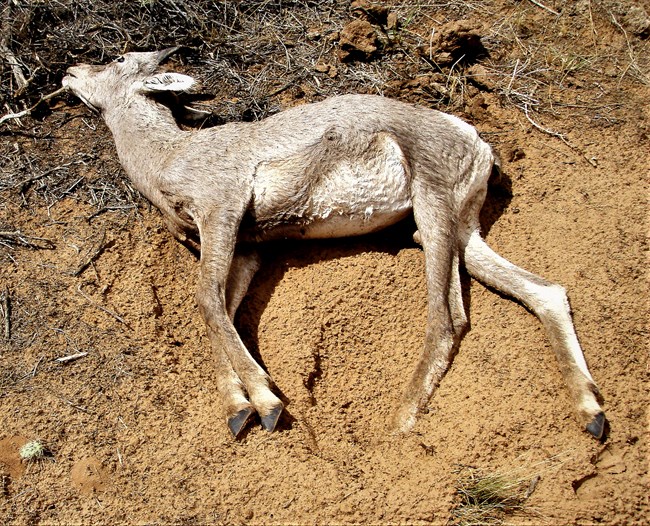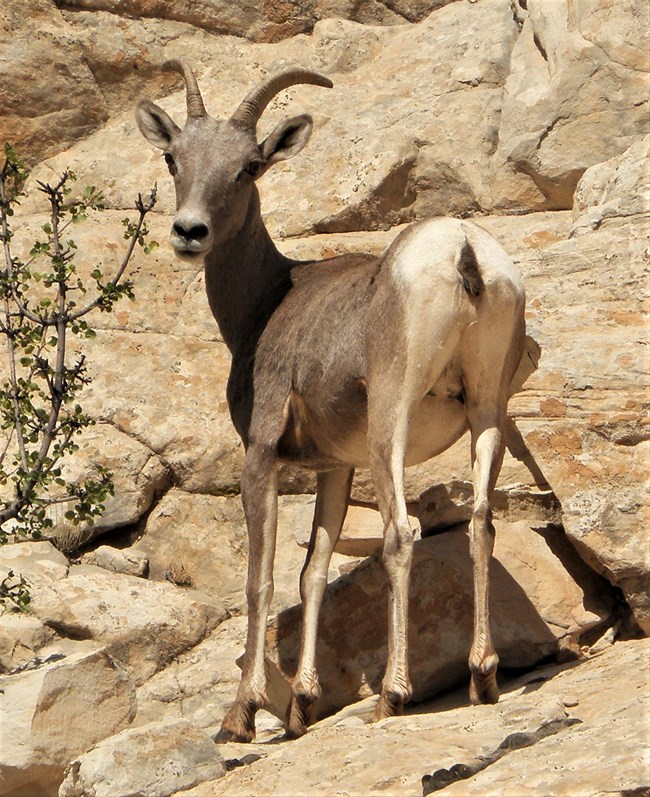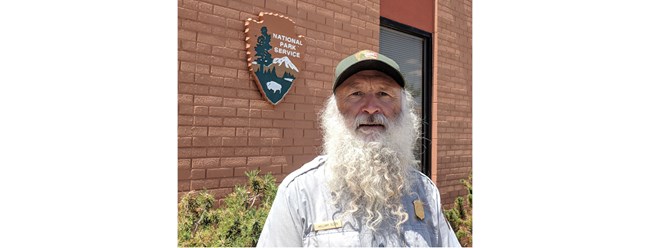Last updated: December 30, 2022
Article
An Infectious Strain of Pneumonia Threatens Capitol Reef's Prized Bighorn Herd
Capitol Reef National Park’s bighorn sheep herd grew almost fourfold since being introduced from Canyonlands over two decades ago. Now the herd is at risk from a debilitating disease.
By William Sloan, with Morgan Wehtje

Image credit: NPS / Chris Roundtree
It was a hot August morning in 2018 in Capitol Reef National Park’s backcountry. The sublimely soft beauty of the sandstone cliffs towering above me was offset by the smell of death. It emanated from the bloated carcass of a bighorn lamb as I hesitantly sawed through the fur and into its neck. Each passage of the sawblade released more stench from the gases inside the decomposing animal. It was an unpleasant task but one I was determined to see through. I needed to remove the head, which is less subject to decay, so it could be tested for disease. We had to know what was making members of the park’s iconic herd sick.
Troubling Symptoms
Six days earlier, I had located a group of 11 sheep, including three lambs, in the rugged east-central core of the park. Two of the ewes were frequently sneezing. Not a good sign for sure, but the male lamb’s condition was what really concerned me. The lamb’s agape mouth, rapid respiration, nasal discharge, coughing, and emaciated body indicated it was probably suffering from pneumonia, caused by the bacterial pathogen, Mycoplasma ovipneumoniae. The coughs were from deep in the agonized animal’s lungs, convulsing its entire body and echoing off the slickrock and sheer-walled cliffs around me.
Scientists first isolated the pathogen in Australia in 1972 in domestic sheep. Since then, researchers have found it in many wild animals. The disease can be deadly and can predispose an animal to other respiratory infections, but much about it is still unknown.

NPS / William Sloan
I followed and studied this group of sheep for four days as the lamb’s condition weakened. Then seasonal monsoonal thunderstorms and resultant flash flooding prevented me from observing them for two days. When I returned after the flooding abated, I found the dead lamb on a freshly rain-washed, sandy bench high above the sinuous watercourse. It had died prior to the last heavy rain that erased tracks from 30 hours ago, but I saw a set of fresh sheep tracks near the carcass. The carcass was still fully intact when I returned the next morning with tools to take nasal swabs and remove the head.
As I persisted in my gruesome task, two sheep approached within 60 feet to watch. I’ve witnessed similarly mournful behavior in wild sheep before, so I suspected the ewe to be the dead lamb’s mother and the young male to be her older sibling. Matrilineal bonds are strong in bighorn, and I was interrupting their familial grieving. The dam and yearling ram observed me from close range before engaging in erratic, grief-stricken behavior, running back and forth near the soon-to-be-headless carcass. I felt guilty—and nauseous from the smell and gases—and some lines from an old Neil Young song began echoing in my mind as I removed the head on behalf of science:
I searched out my companions
Who were lost in crystal canyons
When the aimless blade of science
Slashed the pearly gates
I double-bagged the lamb’s head, put it in a backpack, and carried it three miles back to the truck. Unpleasant for sure, but surprisingly, I kept my breakfast down.
A Serious Threat to a Growing Herd
As I suspected, the test results came back positive for the disease, the first documented case in this Capitol Reef herd. I helped the park start this herd in 1996 and 1997 with sheep translocated from Canyonlands National Park. This translocation was necessary to restore sheep to prime habitat that had been vacant since the native herd died off due to human activities in the 1930s. The original 40 translocated animals in Capitol Reef grew to an estimated 130 animals by 2006, the last year a few of the surviving original translocated sheep had active radio collars.
I had studied their growth and dispersal intently from the time of translocation until 2006. Each year, the herd grew steadily in number, dispersing and expanding further into unoccupied ranges. Although some sheep died from puma predation and other causes like vehicle collision, sheep survival rates remained high and the herd appeared to be disease-free. My unpublished data and papers show those trends continued for the decade following the translocation and into the next several years.
Our concern was heightened in the winter of 2021–2022, when Morgan Wehtje, the park’s biologist, observed more sheep with wracking coughs, nasal discharge, and emaciated bodies.
The detection of this strain of pneumonia in the Capitol Reef herd in 2018 was alarming, as it threatened the herd’s health and very survival. During the next three years, park staff saw a few additional sick and dying animals, which subsequently tested positive for the disease. Our concern was heightened in the winter of 2021–2022, when Morgan Wehtje, the park’s biologist, observed more sheep with wracking coughs, nasal discharge, and emaciated bodies. The park euthanized and tested one sheep and tested another within an hour after park volunteers watched its convulsive death throes. Both were positive for the pathogen.
Capturing an Accurate Picture
The outbreaks at Capitol Reef and need for more information about the herd prompted Wehtje to secure year-end funding from the National Park Service. We used this to support a lamb survival study in late June and early July 2022, with a follow up in late September. Because this is an emerging invasive disease, we still know little about the virulence and lethality of its different strains. Monitoring early lamb survival can tell us whether the disease is active or latent in local populations. At Capitol Reef, lambs are born from late April through early June. Virulent strains can decimate a herd by killing nearly all lambs within the first six to eight weeks, but weaker strains may allow recovery and increase immunity against more deadly strains.
Capitol Reef has an ongoing program to monitor wildlife with game cameras. The winter 2021 deaths prompted the Capitol Reef scientific staff to use their game cameras to monitor important lambing habitat and bighorn sheep movement areas in the vicinity of the fatalities. The park hoped camera data would give us images of any sick or diseased bighorn sheep. Using camera data locations and my previous knowledge of the herd, we studied lamb survival in the central portion of Capitol Reef. Our survey area was between the Chimney Rock-Spring drainage system north of the Fremont River extending south to Burro Wash.

Image credit: NPS
We hiked into remote study areas to survey for tracks, scat, and other animal signs and looked for sheep with high-powered binoculars. We selectively and comprehensively surveyed critical habitats of known herds in the central area of the park, where the disease was detected. The terrain in the park is rugged and we had little time, so we limited our efforts to creeks, washes, and ridges within six miles of a road. We observed groups of sheep for up to four hours each.
Good News
In my 2022 midsummer surveys, I saw 25 individual bighorn sheep: 11 adult ewes, 11 lambs, one juvenile ewe and two yearling males. Sheep move and intermingle but often form small sub-herds and use distinct areas. I was familiar with this population, the areas it uses, and the different make-up of its sub-herds. This assured us the individuals I was seeing were not repeated sightings of the same animals.
Most bighorn ewes give birth to one lamb per year. The fact that there was a lamb for every ewe showed that the lambs we saw in this herd were surviving well. With the exception of one coughing and weak female lamb, I saw no obvious health issues in fourteen hours of observation over four days. The presence of the juvenile sheep indicated some young were surviving and the possible absence of a wide-spread die off from disease in the previous year. This was only a subset of the park population but hopefully representative of the herd’s overall health. The images collected with game cameras also showed bighorn sheep with no signs of nasal discharge, in good condition, and with most ewes having lambs.
The more we observe and learn about the herd’s reaction to the disease, the better we can respond to it.
We continued monitoring sheep with cameras and did a limited follow-up survey in September to determine late-summer lamb survival rates. The replenishing monsoon season rains typically enable animals to disperse farther from perennial water sources, so bighorn sheep numbers would be lower overall within the study area in September. But these supplemental findings would nonetheless be important.

NPS / William Sloan
Flash flooding limited our access to the study area during the late summer survey. There was also an active pair of mountain lions—a mother and daughter—within the study area, which may have caused sheep to avoid it. Despite a smaller sample size of seven sheep, the results were encouraging, as the herd still had one lamb per ewe. In eight hours of observation, I did not detect any health issues among the sheep. Recent tracks indicated three large groups of other unseen sheep had frequented the study area days before my survey started, with nine or more lambs surviving for as many ewes.
The camera data again validated my observations, including the sheep’s diminished use of the study area. Although this was a good year for the Capitol Reef herd, we don’t know what the future will bring. But the more we observe and learn about the herd’s reaction to the disease, the better we can respond to it.
Disease Transmission Across Borders
The strain of Mycoplasma ovipneumoniae found in dead Capitol Reef bighorn sheep matched strains found in bighorn sheep in the Bureau of Land Management’s San Rafael Swell Recreation Area, close to the park’s northern boundaries. This suggests animals moving across the park’s borders are sharing diseases. The pathogen was also recently found in Canyonlands National Park, the origin of the Capitol Reef herd and originally thought to be disease-free, which also hints at a broader shared disease landscape.
These observations give rise to many questions: Are there environmental stressors like inadequate forage or loss of access to water that make herds more susceptible to this pathogen? What are our management options for preventing or limiting disease? How prevalent is the disease in populations across different public land areas? What are the different disease strains present? What role does stress from increasing recreational impacts play?
Although we may not be able to prevent infection, knowing more about disease movement between bighorn sheep populations at the landscape level and what triggers outbreaks will help us answer these questions. This will help park managers decide whether to remove sick animals, limit pressure from visitor recreational activities, or take other actions to protect the health of the herd.
Finding Answers
To be most effective, scientific research to answer these questions must be multi-agency and have multiple funding sources. Managing the disease only for an individual herd is akin to bandaging a bleeding wound without knowing what caused it. To understand why we are having repeated outbreaks, we need to know how animals are transmitting this disease across the landscape. We also need to know whether and how stress affects their disease resistance.
Bighorn sheep can serve to indicate the health of natural habitats: if they can thrive, so can many other species.
The most efficient and accurate way to gain this information is through capturing and collaring animals to track their movements and collecting tissue samples to determine their genetics and disease status. Captures, satellite collars, and helicopter overflights to observe herds are expensive but will give us the data we need to tease apart landscape-level information.
Bighorn sheep are one of the most iconic mammals in North America, a living symbol of wilderness often depicted in Native American rock art. Park visitors to western national parks eagerly look forward to seeing them. Bighorn sheep can serve to indicate the health of natural habitats: if they can thrive, so can many other species. Answering questions about their health in relation to this debilitating disease is thus vitally important. We all want to see and hear the sleek coats, clattering hooves, and clashing horns of an active, healthy herd rather than the emaciated bodies and gut-wrenching coughing of a diseased one. Our investment in this transplanted herd is great. Let’s keep it healthy.

About the author
Bill Sloan is a wildlife biologist at Canyonlands National Park, Arches National Park, and Death Valley National Park. He has studied bighorn sheep at 27 NPS units for the past four decades. He has published several studies about the recreational impacts of visitation on bighorn sheep populations.
Image credit: NPS
